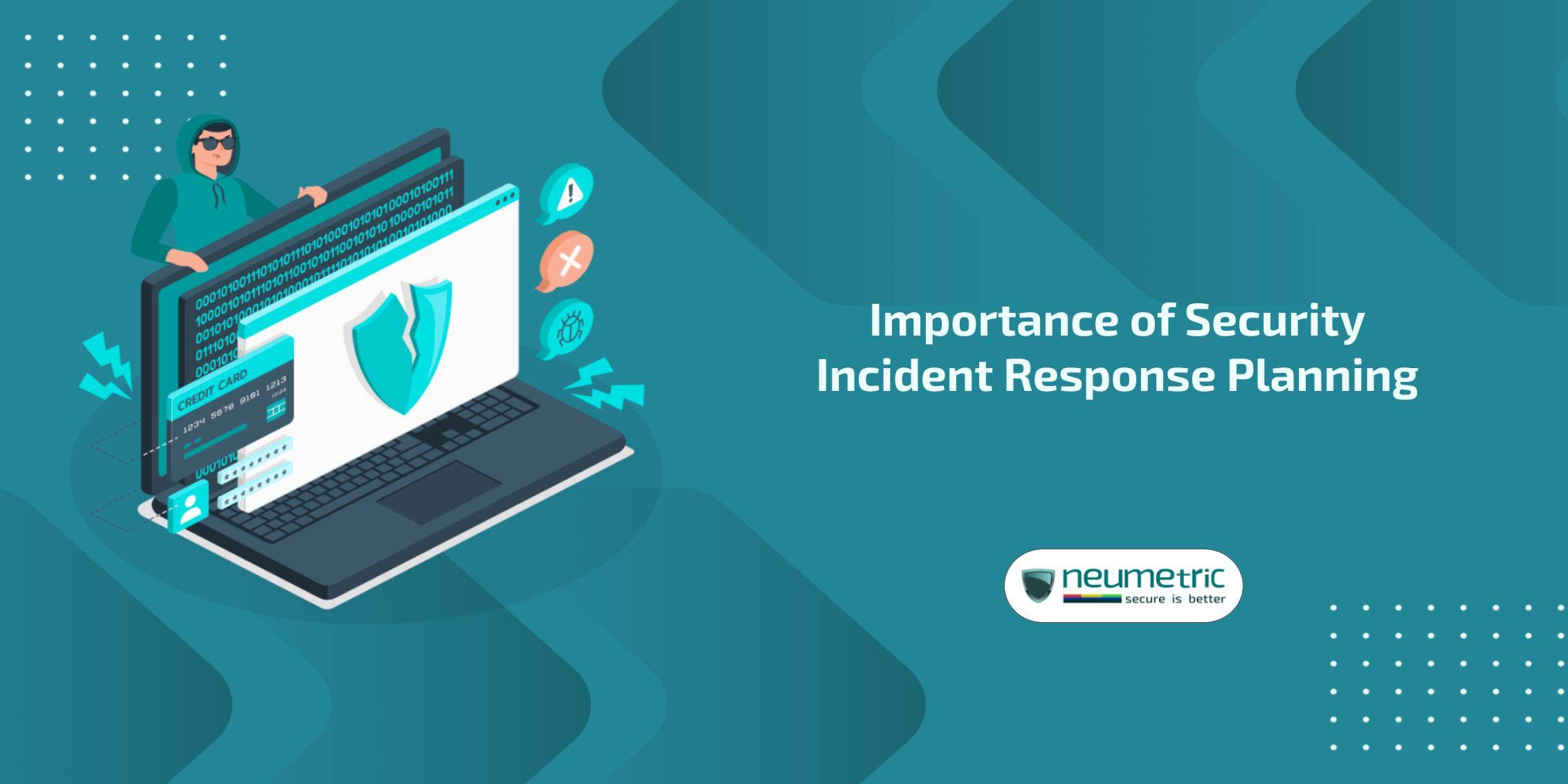Table of Contents
ToggleImportance of Security Incident Response Planning
Introduction
Cyber threats, ranging from sophisticated malware to targeted cyberattacks, pose significant hazards to businesses of all kinds. As the frequency & sophistication of these threats increase, the need for proactive security measures has never been greater. This Journal attempts to highlight the vital significance of Security Incident Response Planning [SIRP] in strengthening an organisation’s resilience to cyber threats.
The present threat landscape is dynamic & ruthless, with cyber adversaries who are persistent, well-funded & extremely innovative. Organisations face a variety of difficulties, such as data breaches, ransomware attacks & advanced persistent threats [APTs]. The interconnectedness of digital infrastructure & the proliferation of devices expand the potential attack surface, making it critical for enterprises to remain ahead of evolving threats.
The goal of this Journal is to explain the vital role of Security Incident Response Planning in navigating the complex & changing threat landscape. By delving into the complexities of incident response, from identifying security issues to post-incident lessons learned, the goal is to give organisations with insights into establishing a proactive & successful response to cyber threats. As we examine the underlying principles & lifecycle of incident response, our goal is to provide businesses with the knowledge & tools they need to improve their cybersecurity posture.
Understanding Security Incident Response
A security incident is any event that poses a threat to the Confidentiality, Integrity & Availability [CIA] of an organisation’s information assets. This encompasses a broad spectrum, including unauthorised access, data breaches, malware infections & system disruptions.
Effective incident response is grounded in several core principles. Timely detection, swift containment, thorough eradication, seamless recovery & a commitment to continuous improvement form the bedrock of a robust incident response strategy. Organisations must not only react to incidents but proactively prepare for & learn from them.
The Lifecycle of Incident Response
- Identification: The first element of incident response is to identify & acknowledge the occurrence of a security event. This necessitates a combination of technological tools, such as Intrusion Detection Systems [IDS] & human attentiveness in order to spot unexpected patterns or behaviours that may signal a security breach.
- Containment: Once an event has been recognised, the next crucial step is to respond quickly. This entails isolating the afflicted systems to avoid future spread & damage. Effective containment measures lessen the incident’s impact & the risk of escalation.
- Eradication: With the incident contained, the focus shifts to eradicating the root cause. This involves removing the threat actor’s presence, eliminating malicious code & closing vulnerabilities to prevent a recurrence of the incident.
- Recovery: After eradicating the threat, the organisation enters the recovery phase. This includes restoring affected systems & data to normal operations. A well-defined recovery plan ensures a swift return to business as usual while minimising downtime & disruption.
The High Stakes of Inadequate Incident Response
Financial Implications
Inadequate incident response can have profound financial implications for organisations. When a data breach occurs, the immediate costs involve identifying & containing the breach, notifying affected parties & providing credit monitoring services. However, the true financial impact extends beyond these initial expenses. Costs may include legal fees, regulatory fines for non-compliance & the potential loss of Intellectual Property [IP]. Calculating the full extent of financial damage requires factoring in direct costs, legal repercussions & the long-term impact on the organisation’s bottom line.
The aftermath of a security incident can lead to long-term financial repercussions. Customer trust, once eroded by a data breach, may result in decreased revenue as customers opt to take their business elsewhere. Additionally, the costs associated with rebuilding & fortifying security post-incident contribute to ongoing financial strain. Investing in effective incident response measures becomes not just a security imperative but also a strategic financial decision to safeguard the organisation’s financial stability in the long run.
Reputational Damage
Inadequate incident response has a significant impact on the intangible but vital currency known as trust. Customer trust is created over time by consistently providing secure services & protecting sensitive information. A security breach, particularly one in which consumer data is compromised, undermines this trust. Customers may question the organisation’s commitment to their security, exposing the fragility of trust & resulting in reputational damage that lasts far beyond the immediate aftermath of the occurrence.
Rebuilding trust after an incident is a difficult but important task. Transparent communication, admitting the occurrence & describing specific efforts taken to prevent future intrusions are critical. Offering restitution, such as identity protection services, displays a commitment to reducing the impact on those harmed.
Anatomy of a Security Incident Response Plan [SIRP]
Crafting a Comprehensive Plan
- Creating a Cross-functional Incident Response Team: A comprehensive Security Incident Response Plan [SIRP] starts with the development of a cross-functional incident response team. This team consists of people with a wide range of talents, including information technology, law, communication & executive leadership. Creating a multidisciplinary team ensures that all areas of incident response, from technical remediation to legal compliance & communication strategies, are thoroughly handled.
- Define Roles & Responsibilities: Clear roles & duties for the incident response team are critical. Individuals are assigned specific tasks, such as incident detection, containment & communication, which helps to streamline the response process. Each team member should understand their position & be well-prepared to carry out their obligations quickly & effectively during an emergency.
Key Components of an Effective SIRP
- Incident Identification & Classification: The SIRP should include specific methods for recognising & classifying security incidents. This includes using monitoring tools, analysing data & applying anomaly detection to quickly identify potential risks. Incidents are classified based on their severity, allowing the team to properly prioritise & deploy resources.
- Incident triage & initial assessment: Once an incident has been detected, a methodical triage approach is necessary. The initial evaluation entails determining the scope, impact & type of the occurrence. This informs the next phases, which include containment & eradication attempts.
- Communication Protocols: Effective communication is critical in a security event. The SIRP should describe communication mechanisms for both internal & external stakeholders. Communication that is timely & honest aids in story management, instils confidence & demonstrates organisational control in difficult circumstances.
- Incident Containment Strategies: Containment is an important element of incident response & the SIRP should include methods for isolating & reducing the impact of the incident. This could include isolating impacted computers, deactivating compromised accounts or installing network segmentation to prevent attackers from moving laterally.
- Data Recovery & System Restoration: After containment, the SIRP guides the organisation through the recovery phase. This includes restoring data & systems to normal operations. Backups, tested regularly, play a crucial role in ensuring data integrity & swift recovery.
The Human Element in Incident Response
Training & Awareness Programs
The human element plays a pivotal role in effective incident response. Training & awareness programs are instrumental in equipping the entire workforce with the knowledge & skills necessary for incident reporting. Employees should be educated on recognizing potential security incidents, understanding reporting procedures & the importance of promptly reporting any suspicious activity.
Beyond the broader workforce, the incident response team itself requires continuous training. As the cybersecurity landscape evolves, new threats & attack vectors emerge. Regular training sessions ensure that incident response team members stay abreast of the latest developments, refine their skills & are well-prepared to tackle evolving cyber threats.
Fostering a Culture of Vigilance
To foster a culture of alertness, security awareness must be raised throughout the organisation. This extends beyond the IT department & includes all employees. Security awareness programmes should emphasise the importance of cybersecurity, the possible impact of security incidents on the organisation & the responsibility that each individual has in ensuring a secure environment.
Establishing a proactive reporting culture is critical. Employees should feel comfortable reporting anything odd without fear of repercussions. Encouraging an open & proactive reporting culture helps to detect incidents early on, allowing the incident response team to respond quickly & prevent security concerns from escalating.
The Evolving Threat Landscape & Incident Response
Cybersecurity Trends
- Ransomware An Increasing Threat: The changing threat landscape poses new problems, with ransomware emerging as a particularly widespread & damaging threat. Ransomware attacks encrypt an organisation’s data & demand a payment for its release. Understanding the Tactics, Techniques & Procedures [TTPs] used by ransomware perpetrators is critical to effective incident response.
- Advanced Persistent Threats [APT]: Advanced Persistent Threats [APTs] are a sophisticated & focused type of cyberattack. APT actors, who are frequently state-sponsored or well-funded, use stealthy tactics to infiltrate systems & sustain unauthorised access for extended periods of time. Incident response plans must be tailored to the specific characteristics of APTs, such as their persistence & ability to circumvent typical security measures.
Aligning Incident Response with Emerging Threats
- Adapting Incident Response Plans to Current Threat Vectors: As threats evolve, organisations must update their incident response plans to address current threat vectors. This includes continuous modifications to incident response protocols, taking into account the unique indicators of compromise associated with common threats such as ransomware & APTs.
- The Role of Threat Intelligence in Incident Response: Threat intelligence is critical in coordinating incident response with developing threats. Organisations can improve their proactive defence strategies by harnessing timely & appropriate threat intelligence. Threat information provides incident response teams with the most recent strategies used by threat actors, allowing for a more educated & effective response.
Testing & Refining Your Incident Response Plan
The Importance of Tabletop Exercises
Tabletop exercises are invaluable for testing the effectiveness of an incident response plan. Simulating realistic scenarios, such as a ransomware attack or a data breach, allows the incident response team to practise their roles & responses in a controlled environment. These exercises help identify strengths, weaknesses & areas for improvement in the incident response plan.
Through tabletop exercises, weaknesses in the incident response plan become apparent. These weaknesses may involve communication breakdowns, delays in response or gaps in the containment strategy. Identifying these weaknesses is a crucial step in refining the incident response plan & strengthening the organisation’s overall cybersecurity posture.
Continuous Improvement
Following tabletop exercises, a detailed post-exercise debriefing is required. This entails conducting a thorough analysis of the exercise, including what worked well & what needs to be improved. The debriefing results guide changes to the incident response plan, training programmes & overall cybersecurity strategy.
Continuous improvement is a continuing process. Lessons learned from real-world incidents, simulated exercises & developing threat intelligence should be consistently integrated into the Security Incident Response Plan. This guarantees that the plan stays adaptable, effective & relevant to the ever-changing threat situation.
Regulatory Landscape & Compliance Considerations
Legal Implications of Security Incidents
- Compliance Requirements: In the contemporary digital landscape, legal implications surrounding security incidents are a paramount concern for organisations. Various industries & jurisdictions have established compliance frameworks that mandate specific cybersecurity measures to safeguard sensitive data. For instance, the Health Insurance Portability & Accountability Act [HIPAA] in the healthcare sector, the Payment Card Industry Data Security Standard [PCI DSS] for the payment card industry & the General Data Protection Regulation [GDPR] in the European Union [EU] are examples of regulatory frameworks that impose strict requirements on organisations to protect personal & sensitive information.
- Reporting Obligations: When a security incident occurs, organisations are often obligated to report the incident to regulatory authorities and, in some cases, affected individuals. Reporting obligations vary depending on the nature of the incident, the type of data compromised & the applicable regulatory framework. Swift & accurate reporting are essential not only to comply with legal requirements but also to demonstrate transparency & accountability.
Conclusion
The regulatory landscape & compliance considerations form a critical backdrop to the urgency of Security Incident Response Planning [SIRP]. As organisations navigate the complexities of securing digital assets & sensitive information, understanding & adhering to legal frameworks become integral components of a robust cybersecurity strategy. Several key points highlight the multifaceted nature of incident response planning. The increasing threat landscape, the high stakes of inadequate incident response & the essential components of a comprehensive SIRP underscore the critical importance of being well-prepared for cyber incidents.
The urgency of SIRP is emphasised by the evolving & sophisticated nature of cyber threats. Organisations cannot afford to adopt a reactive stance; instead, they must proactively invest in planning, training & resources to effectively respond to incidents. The financial implications, reputational damage & legal consequences of inadequate incident response heighten the imperative for organisations to prioritise & allocate resources to develop & maintain robust incident response capabilities.
In an era characterised by cyber uncertainty, the path forward involves building resilience through proactive Security Incident Response Planning. This resilience is not only about defending against cyber threats but also about swiftly responding & recovering when incidents occur. Recognizing the inevitability of security incidents, organisations must cultivate a culture of vigilance, invest in continuous training & align incident response with emerging threats.
As technology advances & threat actors evolve their tactics, the commitment to cybersecurity resilience becomes an ongoing journey. The conclusion serves as a call to action for organisations to embrace the urgency of SIRP, learn from the insights provided & forge ahead on the path of building resilience against the dynamic & ever-changing landscape of cyber threats. By doing so, organisations can navigate the regulatory landscape, comply with legal obligations & instil confidence among stakeholders that they are prepared to face & mitigate the impact of security incidents in the digital age.
FAQ
Why is Security Incident Response Planning important for organisations?
Security Incident Response Planning is crucial as it provides a structured approach to identify, manage & mitigate the impact of security incidents, ensuring a swift & effective response to cyber threats.
How does a proactive reporting culture contribute to incident response?
A proactive reporting culture empowers employees to report potential security incidents promptly, facilitating early detection & enabling the incident response team to take swift action, minimising the impact of the incident.
Why is continuous improvement essential in incident response planning?
Continuous improvement, achieved through regular testing, debriefing & learning from incidents, ensures that incident response plans remain adaptive, effective & aligned with the evolving threat landscape.





